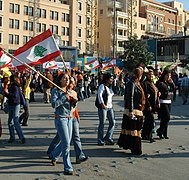Gender equality in Lebanon
Gender Equality in Lebanon is the attempt that all men and women should receive equal treatment in all aspects of the society without discrimination on their sex. Equality in Lebanon has witnessed controlled attempts towards achieving gender equality. For example, Lebanon was a leading country in the middle east region and pioneered female rights to be enrolled in politics in 1953. Another important date in the Lebanese context to fight gender biases was 1996 where Lebanon endorsed the Convention on the Elimination all Forms of Discrimination Against Women (CEDAW).[1] One of the main reasons for this gap in promoting gender equality is attributed to the over all education policies in the country where the present curricula is irrelevant to advocate for gender equality. Adding to this, some believe that cultural concerns play a big role in this educational tendency of overshadowing gender equality where still women's' roles in society are viewed with a lot of biases and discriminations perceptions.[2]
Personal status laws also play a crucial role in shaping gendered modes of citizenship by reinforcing gender disparities in citizenship rights and perpetuating the intertwining of sex and sect in legal frameworks.[3]

History
Lebanon is considered as one of the most active countries in the middle east calling for women empowerment and gender equality both on the legal and societal levels. These attempts for change has been influenced by many conflicts and wars that took place within and around the country.[4] Discrimination is practiced among different sectors and professions and this gap differs from one sector to another.[5] Culture plays a big role in widening the gender gap in Lebanon.[6]
Gender equality and education
The UNDP and other partners of UN global community made gender equality a major concern within the Lebanese context. There was an increase number of female enrollment in primary education compared to what it was like 15 years ago. Females today represent around 41 percent of paid employees in different industries.[7]
Activity gallery
- Women engagement in Lebanon
-

-

-

-

References
- ^ Melki, Jad; Mallat, Sarah (2013), Byerly, Carolyn M. (ed.), "Lebanon: Women's Struggle for Gender Equality and Harassment-free Newsrooms", The Palgrave International Handbook of Women and Journalism, London: Palgrave Macmillan UK, pp. 432–448, doi:10.1057/9781137273246_31, ISBN 978-1-137-27324-6, retrieved 2021-06-05
- ^ "Performance Management and Support Program for Lebanon(PMSPL II)". USAID Lebanon. 2019.
- ^ Mikdashi, Maya (2022). Sextarianism: Sovereignty, Secularism, and the State in Lebanon. Stanford: Stanford University Press. pp. 24–47. ISBN 9781503631557.
{{cite book}}: CS1 maint: date and year (link) - ^ nanor (2020-02-28). "Setting the Agenda towards Gender Equity". Civil Society Knowledge Centre. Retrieved 2021-06-06.
- ^ Melki, Jad; Mallat, Sarah (2013), Byerly, Carolyn M. (ed.), "Lebanon: Women's Struggle for Gender Equality and Harassment-free Newsrooms", The Palgrave International Handbook of Women and Journalism, London: Palgrave Macmillan UK, pp. 432–448, doi:10.1057/9781137273246_31, ISBN 978-1-137-27324-6, retrieved 2021-06-06
- ^ "Can Women Speak Out in Lebanon?". iwpr.net. Retrieved 2021-06-06.
- ^ "Goal 5: Gender equality | UNDP in Lebanon". UNDP. Retrieved 2021-06-07.
External links
- KAFA
- The Lebanese Democratic Women’s Gathering (RDFL)
- .Lebanon Family Planning Association for Development & Family Empowerment (LFPADE)
- Justice Without Frontiers (JWF)
- Palestinian Arab Women League
- Marsa Sexual Health Center
- Nasawiya
- ABAAD
- The Arab Institute for Women















